This is part 3 of my series on Mars, planet of surprises, great to explore, not so great to colonize. In "Is it as good a place to live as a desert? we saw that Mars is a more inhospitable place than the coldest driest deserts on Earth, and has severe supply issues from Earth. It is a place for highly trained hardy explorers like the early Apollo astronauts.
Then in Life on the edge in cold dry deserts of Mars, we saw that there are possible habitats for life on Mars. Human visitors with their hundreds of trillions of microbes could contaminate the planet. We absolutely should not send human beings to the surface of Mars until all this is thoroughly understood. So, meanwhile, where is the best place in the solar system for newbie colonists?
I'll look at this question briefly, and then in the next article will return to Mars exploration, and ask if our hardy explorers can achieve "boots on Mars" without contaminating the planet.
Last time I showed you the McMurdo dry valleys. This time for a change this is the Atacama desert.
.jpg)
This is the other area on the Earth regarded as perhaps one of the closest analogues to Mars that we have. It is high, it has a thin atmosphere, and it is very dry there. Those conditions make it ideal for infrared astronomy. This photo shows the landscape near the ESA Observatory, the infrared VLT. The climate is a bit different of course, and the atmosphere is far too thick for Mars but it is thought to be one of the closest analogues of Mars on the Earth..
Surprisingly just as for the McMurdo valleys, you get life in the Atacama desert, life that is hard to detect. There can be no doubt that this is far more hospitable for colonization than anywhere else in the solar system outside of Earth - except distant places in the solar system such as the seas of Europa.
Colonizing deserts on Earth
So if you want to find somewhere new to live in our solar system, your best chance of success is to colonize the deserts on Earth. You can use the desert sands to make glass for your greenhouses, and you can do all the things that suggested for Mars, but do them on Earth. It would cost far less, and far more people would be able to live there than in your few tiny habitats on Mars.
So you might first think, a way to do that, something like biosphere 2, closest perhaps to what you would want to do on Mars.
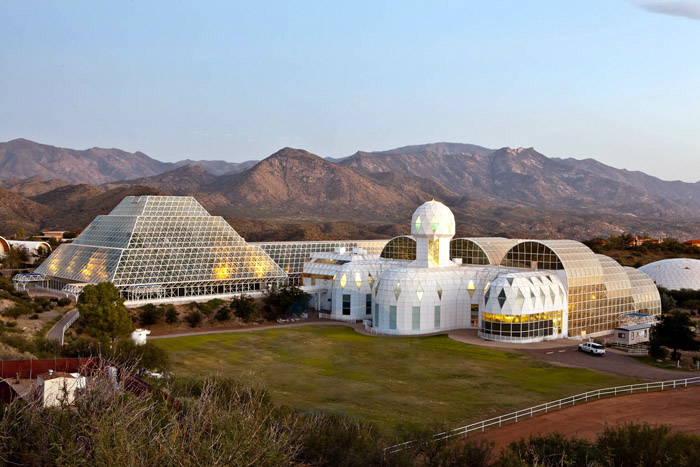
The idea was to have a completely closed biosphere and to generate all the oxygen from the plants and to grow all their own food. As it turned out they were not able to produce enough oxygen and were not able to produce enough food. So this experiment was brought to an end, but learnt a huge amount from it.
With space habitats ideas seem to have turned to more technical ways of producing food using hydroponics (and aeroponics). But perhaps some time we will go back to something like Biosphere II.
Anyway for less than the cost of a Mars mission you could set up colonies of Biosphere IIIs on the Earth, the next step along. You don't need to worry about keeping it self contained, you can just get the oxygen from the Earth's atmosphere - unless you are deliberately doing it as a first step towards colonization of space.
Seawater greenhouses
We also have resources on Earth which we don't have on Mars, apart from oxygen, we also have seawater. Many of the deserts on the Earth are close to the sea. This is the seawater greenhouse.

The way it works is that you have water that comes in from the deep sea, so it is cold, comes into the greenhouse and helps to cool it down in the very hot desert sun, The hot desert sun also causes the seawater to evaporate. This also keeps it humid inside, provides water for the greenhouse, and it provides so much water it is too much for the greenhouse. This water can be used for irrigating the desert outside of the greenhouse and grow trees outside it.
This is a very interesting project. There are of course many projects to green the desert, in Israel and various parts of the Sahara desert, and some very advanced projects where parts of the desert are greened using irrigation, using subsurface aquifers from the desert. But these can be a bit controversial sometimes because you are using up water from deep underground, and so you have to look at it in a case by case basis, if this is a wise thing to do.
This is interesting though because it doesn't do that. It does the opposite. It actually contributes water to the desert. So as a result of building this project and leaving it running you get water continually irrigating the desert and it comes from seawater. It doesn't use any sub surface aquifer and if anything it is replenishing them. So that is the seawater greenhouse, a very interesting project for colonizing the deserts of the Earth.
Now this is the Sahara Forestation Project.
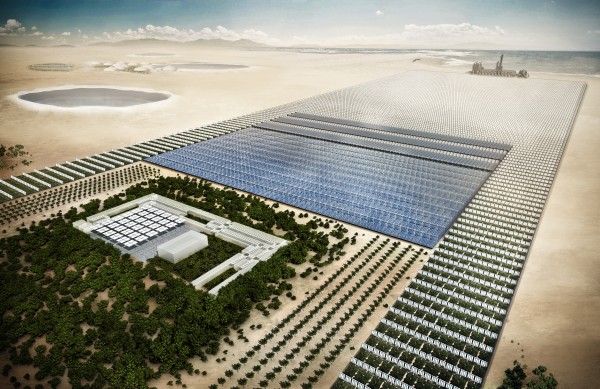
They only have a tiny pilot project in Qatar which is basically a seawater greenhouse project. This is an artist's impression of how it could develop in the future. So this shows a huge area of greenhouses in the desert, close to the sea supplied by the seawater. This shows the trees supplied by the excess water from the greenhouses, and the greenhouses produce crops and they also produce algae for fuel, and this could support many local people. So for the cost of a very small colony on Mars, you are talking about billions of dollars, and I am sure you could cover large areas of the desert with these seawater greenhouses and it would support many people, and is an extra colonization and is reversing desertification and so forth.
So if you are looking for somewhere to live, Earth is most definitely the very best place in the solar system to go to, to colonize.
There is also beneath the sea as well, especially shallower areas below the sea where is the light from the sun. There are many ideas to colonize the sea bed. This is much less advanced than ideas of reversing desertification of the deserts. But potentially long term that is another very large habitat where humans could live as well. Especially in the shallower seas. Of course there are lots of questions about conservation of the seas, but that's the same question you have on the land as well. So it would have to be carefully done, but it is certainly possible you could have colonies on the bed of the sea, and again, you could start a very large sub sea colony for the same costs as starting up a mission on Mars.
Reasons for going into space
So this suggests that if we are going into space we are not going there because we are looking for somewhere to live .We have some other reason for going into space.
You might do it because you are a hardy explorer, like the Apollo astronauts, and then you would be heading anywhere in the solar system including Mercury, Venus, Jupiter and so on. And you would take extreme risks and so forth.
Or you might be gong into space because you are a tourist and you are going out to visit space. And you might go into space because you want to mine the resources of space. Or you might be going into space because of the science value and you want to study it. Or finally you might be going into space because you are an artist and want to paint the landscapes there. Or because you are a musician or poet and are going to be inspired by the space environment. I think definitely space is not a place only for scientists.
However it does have tremendous science value and so I imagine that might be quite a strong driving force to start with.
Where should we go for our first humans colonies in space?
So then where are we going to go first if we are colonizing space, and to set up these first colonies for the tourists and the scientists and the miners and so forth?
Well the obvious place, on a surface, is the Moon. Especially because you have got the stunning landscapes as well, so you have the possibility of the space tourists. It is very easily accessible. There are none of the supply problems of Mars, and there are none of the communication problems of Mars. It is turning out that it is far more interesting than it was originally thought. The landscape is bright so you don't have the dull landscape of Mars. You don't have the problem of possibly getting depressed because it is so dim there all the time. And we know surprisingly little about the Moon considering how much exploration has gone on. What we are discovering is becoming more and more interesting, as we find out about it.
This is from the Apollo 15 mission to the Moon.
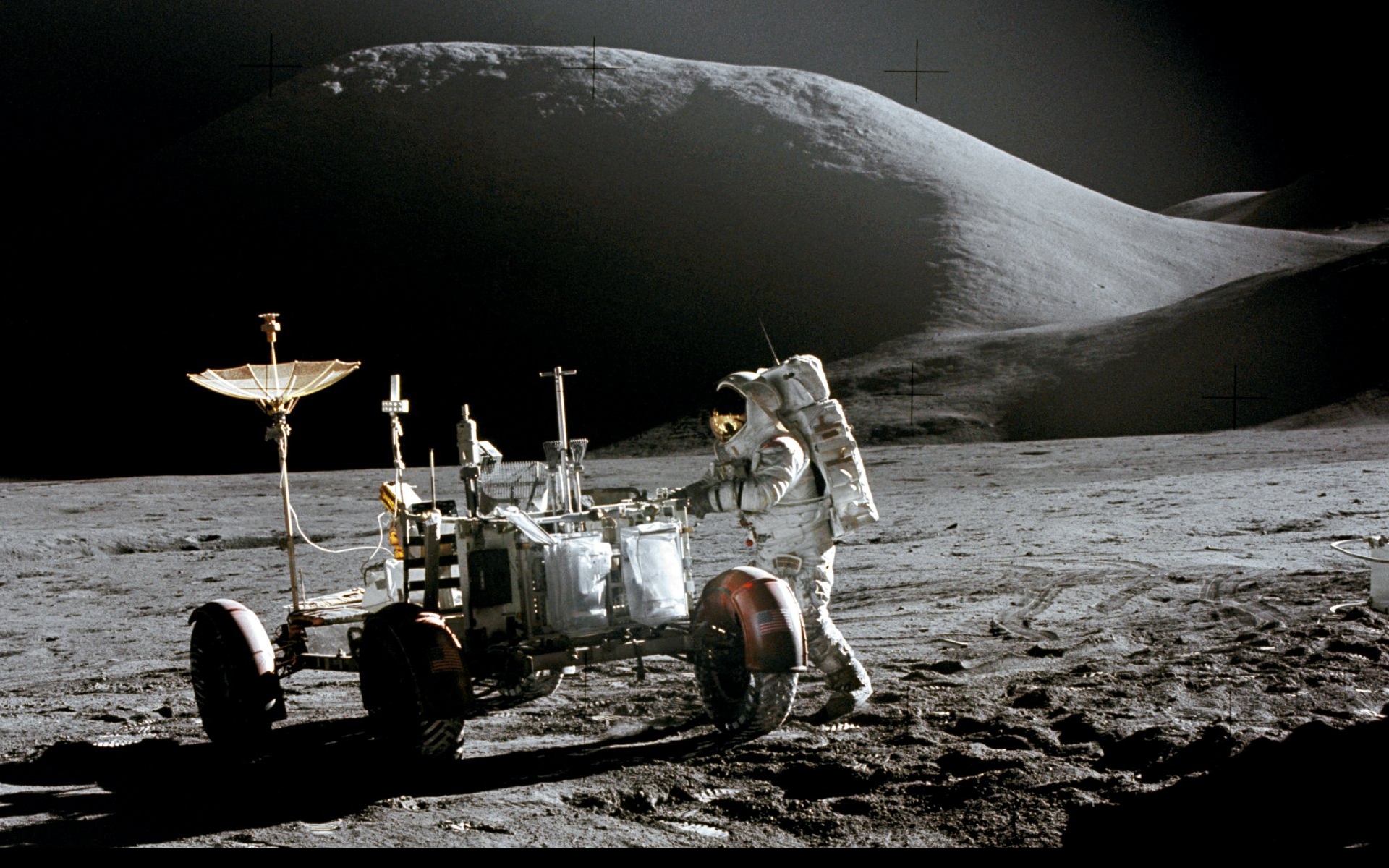
You can tell from the rover that it is not the very first, they didn't have the rover. The first people who were sent to the Moon were all jet figher pilots, highly trained people able to respond quickly in an emergency, able to think clearly in extreme danger, fast thinking people, and resourceful people. If you are going to send humans to the Moon, this is exactly what is needed. As the lunar missions continued, towards the end it was thought safe to send the very first scientist to the Moon. (This was Harrison Smitt, with a PhD in geology, who learnt to become a jet fighter pilot, was responsible for geological training of the earlier astronauts and then finally went himself on the last mission to the Moon, Apollo 17).
He was also the very first non US military astronaut. (not first civilian because Neil Armstrong left the military before he landed on the Moon, but first who never was in the military).
Before then, with all the previous astronauts, you are talking about jet fighter pilots up there. They were not notable scientists. They were notable jet fighter pilots. This means that nearly all the rocks that were returned from the Moon were returned by jet fighter pilots. You may look at this and see this wonderfully clear picture of the Moon but this was not available to the people on the Earth at the time. This was taken with a film camera and later developed. We didn't have the technology then to transmit a photograph like that from the Moon all the way to the Earth.
The actual pictures we saw from the Moon were very low resolution, hard to make out, with quite a lot of interference as well. It certainly wouldn't have been possible for geologists to give detailed advice about which rock to pick up. So the only lunar rocks that were returned by a geologist were with the very last mission. And one of the rocks he returned was dubbed the most interesting rock that has been returned from the Moon.
Rock from Apollo 17. collected by Harison Schmidt, dubbed "the most interesting rock that has been returned from the Moon.
Which is no surprise and any of the other astronauts would have walked straight past it no doubt and not realised it was so interesting.
So although we have had so many missions to the Moon, we haven't had very much by way of science missions to the Moon. It wasn't science led. Carl Sagan, he was interested in the science value of the missions above all, and he argued against sending humans to the Moon, and then once the humans were there, he argued very strongly to maintain and continue sending more humans to the moon. The reason was, he was saying, having designed the lunar module and the command module and so on, that was the expensive bit. He was then saying we could churn them out, and it cost much less to create more of those. Each mission, it was counted in millions for each new lunar mission. He said it was a bit like building a new Rolls Royse and then you just take it for a few spins around your town and then you just leave it in a garage and forget about it. So that basically is what we did with Apollo.
After the very last of the Apollo missions, simply no-one has returned to the Moon. There can be no doubt that if there had been scientists sent to the Moon then we would have found out a tremendous amount more about the Moon than we can at present with orbital missions. It has turned out that the Moon is far more interesting than we thought it was during the Apollo missions.
Moon is more interesting than we thought in the Apollo era
One discovery that has been is that there is surprisingly more water on the Moon than was realised. First, there is a small amount of water in the regolith which is the area of dust and small rocks on the surface of the Moon. In the regions near the equator is a very small amount, a couple of table spoons per tonnne. As you get towards the poles is more, is a couple of kilograms per tonne. Now you can also extract metals from the lunar soil, and as a biproduct you get oxygen. Just processing it in order to get water is probably not very feasible but if you are also processing it to get oxygen and metal at the same time and processing it in various ways to get your habitat, you can well imagine that this two kilograms per tonne might well be a useful amount of water on the Moon.
Then the other possibility of water at the poles of the Moon, it is thought there might be as much as 5% by weight of water ice when you get to the perpetually shaded craters at the poles of the Moon which I like to call the "craters of eternal night". Anyway before talking about that - it turns out that the poles are probably the very best places to colonize but lets start by talking about the equatorial regions and the various challenges and interests of that.
Colonists and tourists on the Moon
So first, for the space tourist, it's far more interesting than you might have guessed from the first Apollo missions, because they deliberately targetted very flat areas of the Moon. You do have mountains.They are created by the craters, sometimes in the middle of the craters and the rims of the craters. You also have lava tubes and caves within the lava tubes and you have the rilles. So it is quite a varied landscape really. Then at night you would be able to see all the stars surely, very bright, and the milky way, and if you are on the Earth side, you would see the Earth slowly turning in the sky. So it could be a very nice place to live in some ways.
Other things make it not so very nice place to live. Particularly you have, when it's in the sun it gets very hot, and here the sun would be over 100 C in temperatures. At night it would be extremely cold. So with your habitat you have to be very careful to deal with that. So one way to deal with the temperature extremes is to cover your habitat with lunar soil, which would also help with the radiation. Or you might possibly build it within one of the caves of the Moon especially for the first habitats.
Power supply issues
Then you also have the problem that you have no solar power during the night. The usual way of solving that is to have some kind of nuclear power station, some kind of use of fission power. That is not such a problem on the Moon as on the Earth because you have no natural system that could be contaminated. So it is not really too much of a problem having nuclear waste on the Moon because wherever it is, it is just going to sit there. Although I am very concerned about nuclear power on the Earth until it is well developed, I am not so concerned by nuclear power on the Moon because there is no ecosystem to be contaminated by it.
However there is one other way of supplying power to the equatorial regions. Now I'm going to clearly label when it is an idea of my own rather than an idea I have seen in a paper or something like that and this is one of those.
So this is combining several ideas. So there is the idea of solar panels in the desert many of those, could supply electricity to the whole of Europe because if you have the right kind of cables you can supply electricity over thousands of kilometers.

Area of the Sahara desert needed to supply electricity to Germany, EU and the world for Desertec
Desertec plan for supplying power to Europe and rest of the World from the Sahara and other deserts. My wild idea is to apply the same idea to the Moon
It might be possible to supply electricity for the whole of Europe from solar panels in the Sahara desert. This could be an export of the Sahara desert. Especially with the prices of solar panels continually going down.
Well I thought, combine that on the Moon - the problem on the Moon is you've got the sunny side and you've got the dark side. As it rotates around you are in the sunny side and you go around to the dark side. For fourteen days you are in the dark side of the Moon which is sometimes facing the Earth and sometimes facing away. Well build a whole lot of solar panels and join them together along the lunar equator by a long distance transmission cable. And on the Moon you are not going to worry that people are going to trample over it, just lay it on the surface.
The circumference of the Moon is 10,921 km so the power would be transmitted a maximum of about 2500 km from the nearest point on the sunny side to the middle of the lunar night. With power loss of 3% per 1000 km for HVDC power cables that seems quite feasible, would be power loss of about 7.5%.
You could also do this at a much smaller scale first with circumpolar transmission lines for settlements close to the poles, which could also link up to solar power stations on the peaks of eternal light.
To deal with the micrometeorites do it as a band, lots of little cables or some kind of fabric or something, a conducting fabric would probably be best of all, as micrometeorites are just going to cause holes in it. Then from time to time you can send engineers to repair the effect of all the micrometeorites.
So that way you could have solar power over the entire surface of the Moon eventually as colonization of the Moon develops, using solar power with HVDC power lines along lines of lattitude and then connecting HVDC power cables to other places on the Moon.
So I think long term this power supply isn't going to be a problem in the long term. If it is going to work on the Earth for Sahara desert and Europe, then surely you can supply power from the sunny side of the Moon to the dark side of the Moon. Shorter term we can use nuclear power if needed.
At any rate whether through nuclear or solar power, one way or another the power supply issue is not such a problem.
So long term the Moon does seem a considerably more habitable place than it was before.
Search for life on the Moon
You might be very surprised to know that the Moon is also interesting for the search for the origins of life. You might wonder, how could the Moon be interesting in that respect because it is completely hostile to life.
When you are near the equatorial regions it is very dry, and what water is there is not available to life, this water that they have discovered. Then at the poles, the ice would be available to life except that it is extremely cold which is why it is in the form of ice and has not evaporated into water vapour long ago in the near vacuum of the lunar "atmosphere". So it would be way beyond any possiiblity of life taking any advantage of it, as far as we know.
So, how could we find out about the origin of life on the Moon? Well this may give a clue.
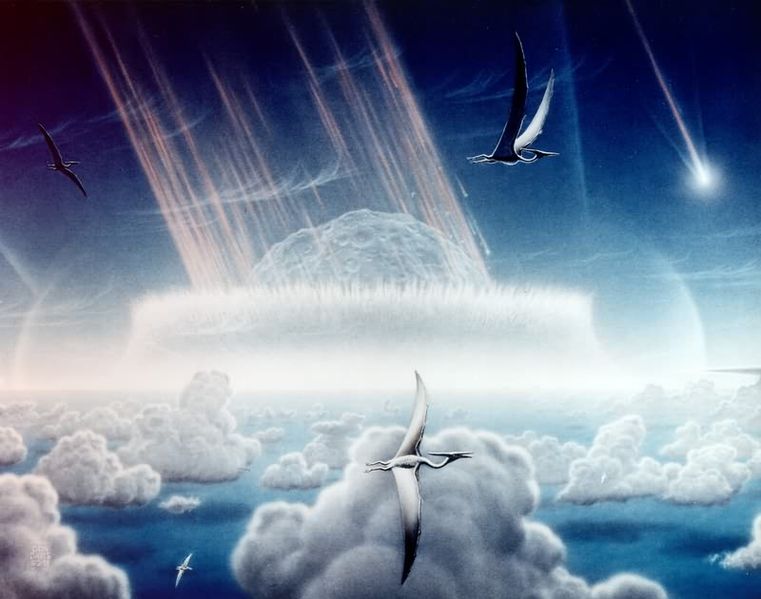
This is an artist impression of the 10 km across meteorite that impacted in what is now Mexico. You can trace out the meteorite crater and you can trace out the effect of it all over the Earth.
This is thought to have contributed to the end of the dinosaurs, and it was such a big impact it is thought that it very probably sent debris into space with escape velocity. Some of that could have hit the Moon. Some of it very probably hit Mars as well. We are talking about a very small amount of debris that would get that far. Obviously most of it ends back on Earth and even if it goes into space ends up back on Earth again. But a small amount could have hit the Moon.
The material that gets sent with high velocity is from the very edge of the crater and is sent off at high speed but only lightly shocked. So it is rather ideal for preserving life in it. At least, as ideal as you can get given that the life is going to be sent off by a meteorite impact. And its thought it could certainly have preserved micro-organisms. My rather wild idea is - is it possible it could even have preserved multicellular life as well? Bits of plants and bits of animals? Anyway that is rather speculative. But is definitively this idea that you could find evidence of ancient life on the Moon.
You would be very lucky to find debris from the K-Pg impact event, as not much would reach the Moon of all the debris from the impact.
However you just look at a cleaer image of the Moon and you can see its huge impact craters, later filled by the Mare, the lunar seas.
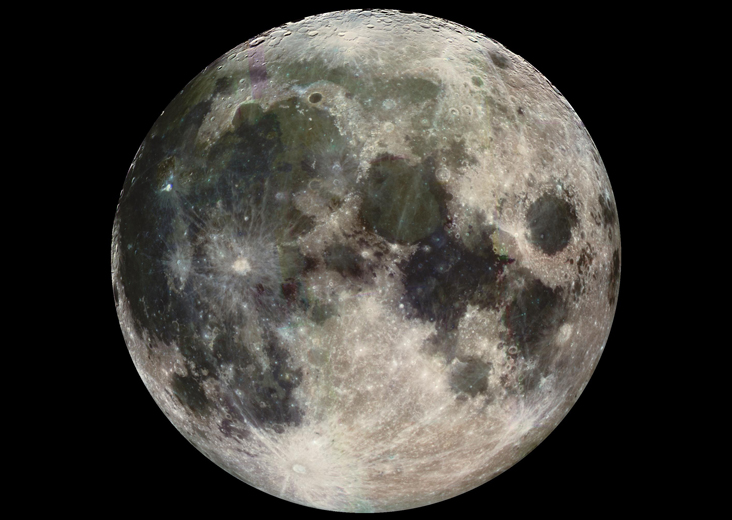
So it is obvious there was a time of great impacts, it is called the "Late Heavy Bombardment" it is actually very early but is late compared with the rest of the impacts as it were. This is a period in the early solar system, there is direct evidence from the Moon that this occurred, an era of huge bodies flying about through the solar system and hitting any of the forming planets or moons.
This is during the time when it was thought that life was starting to evolve on the Earth. Similar impacts would have hit the Earth. It is far too long ago for there to be any geological record of them here, but from the evidence on the Moon it is certain that it must have happened on the Earth as well. So this would have sent masses of debris into space and of that debris, a lot of it would have hit the Moon.
So it's believed, this is not my idea it is generally accepted, that very probably on the Moon there is the debris of these impacts from the Earth. It might be on the surface or you might have to dig to find it, but one way or another, as you explore the surface of the Moon, this is something we may find there.
This gives a lot of interest for study of evolution because you could have fossils or even possibly some organics from that time, if it is buried deep enough to be protected from the cosmic radiation and if it is only lightly shocked and not much metamorphized on the journey from the Earth to the Moon.
So the Moon is a fascinating place. If you want to have tourists and a colony, it is of interest to tourists and is of interest to scientists as well.
Peaks of eternal sunlight, possibly the best place for a first colony on the Moon
This may be the best place on the Moon for your very first colony, before you sort out the power issues and so on, is this place. This is one of the "Peaks of Eternal sunlight".
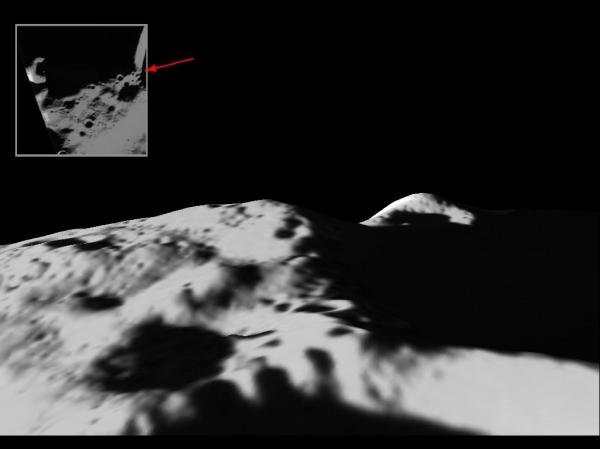
In the inset you see what it looks likeon the maps and the rest shows a simulated view of it on the surface. The brightness in this picture is an indication of how much light is received by each area over the year so the brightest bit is the peak of eternal light.
So this peak of eternal light - it is at the poles of the Moon, and a favoured spot. So even though the Moon is slightly changing its orientation, through all of that, through all the complex motion of the Moon does - an extremely complex motion - they tried to work out the formula of the Moon at the end of the nineteenth century and the formula ran to a couple of pages or something, very complex motion. Through all that complex motion it remains in sunlight except briefly. It certainly would go out of sunlight during the lunar eclipses when the Earth gets between the sun and the Moon. but for most of the time it is in full sunlight. This makes it ideal for a first human habitat and it is also a very interesting place to visit. Because you have solar power all year round. All day and all night.
It is also a constant temperature. So you don't have to adjust your temperature control system according to whether it is night or day. You could grow crops there and could have greenhouses and filter out light when you don't want it for the nights and let it in when you do want it for the day. It is also an ideal location for many things.
For one thing you have the craters of eternal night right next to them. Those have possibly 5% of lunar ice, possibly more than that because that was just one particular location (observation of a plume from an impact). So that is of great value for colonizing the Moon.
Telescopes on the Moon
The craters of eternal night are also a great location for infrared telescopes, passively cooled in the darkness of these craters.
Then the far side of the Moon is an ideal location for radio astronomy. You often hear people talking about the dark side of the Moon. There isn't a dark side of the Moon for light, but there is a dark side of the Moon for the radio waves. Astronomers on the Earth have lots of problems with interference. Just things like your microwave, and cellphones, and sometimes someone might transmiton one frequency and some of it leaks to other frequencies, and television, and GPS, leaking into different channels where they are not expected to be.
So even though there are channels that are set aside for radio astronomy ,still it s quite problematical doing radio astronomy on the Earth. Then most of the spectrum you simply can't do radio astronomy, only these special set aside channels.
On the far side of the Moon you could do radio astronomy across the entire spectrum, no interference from Earth, and it is the most radio quiet place in the solar system, the inner solar system anyway, because there is no interference from the Earth.
Preliminary research and unmanned missions would be needed first
So there are good science reasons and good astronomy reasons and good tourist reasons for thinking this is a very good spot for a first colony on the Moon. You have to be a little bit cautious beause there is also the idea that you might well have science parks on the Moon, areas that you don't want to disturb. My own speculation, it might well be that these areas of ice deposits, some of them, might become parts of the science parks. And it has been suggested that the rocket exhausts particularly could contaminate these areas and you would have to land away from them. I'm not sure if the peaks of eternal light are far enough away from them so that you could land a rocket there and then send a rover down to explore the craters of eternal night. You would probably want to do that without any humans involved to start with.
The humans they could operate from a distance but not actually on the spot. That is my own suggestion. But I think there is gong to be a lot of care taken for the very first missions looking at these deposits to see what exactly is there. But the Moon is so close that with enough funding we could find out a lot very quickly about the Moon.
So, I think that is probably where the first lunar colony would be. Perhaps not necessarily this one as there are several "Peaks of Eternal Light".
Low G solution idea
Now, just to mention another of my wild ideas, I see no problems with it and have talked about it a bit with my facebook friends and some of them are very knowledgeable people and we don't know how people respond to zero gravity. When you have low gravity as in the ISS we have lots of problems. You have bone loss, probably most people know about that, you have the muscle atrophy, they also have problems with their eyes, and sometimes after a long stint on the space station they can't see very well. Usually it recovers on return to Earth but there was one case where it didn't. Then usually you have long term cardio vascular problems. This is all due to the zero g conditions there. With muscle atrophy then when you get back it takes a while to adjust back to walking normally and to hold your head up and things like that.
We simply don't know whether the lunar gravity would be a problem for most of those though it seems probable that you would have a certain amount of muscle atrophy if living in such a low gravity. All these are problems potentially for Mars as well. We have no way to simulate such low gravity on the Earth.
In fact amongst all my disadvantages for Mars I forgot to mention that, we don't know the effects of low gravity.
There is a way around that though I came up with this idea, and the idea is, to have like an observation deck on top of a skyscraper or like a carousel or merryground in a fairgound but a couple of hundred meters across. If you have this slowly spinning habitat, and you spin it at just the right speed you could generate one g on the surface. There is no reason why you have to be restricted to space to have spinning habitats generating artificial gravity.
So, why shouldn't we have our first colonies on the Moon be slowly spinning habitats like that. So that might be an idea to go away with, I've talked about it to my facebook friends and they don't see any problem with it. Though, doubtless you would need to look into many engineering details to get it working on the Moon.
Anyway, maybe our very first lunar colony will be a slowly spinning habitat on one of the peaks of eternal sunlight.
Now after this I'm going to go on and start talking about other ways we can colonize close to the Earth and then will get back to Mars again and ways of exploring Mars.
For the next article in this series see:
4. Space Habitats For Colonists And Mars Explorers - And A Safe Way To Put (Telerobot) Boots On Mars
The other articles in this series so far are
This article is a lightly edited transcript of the video presentation:
3. Reasons not to live on Mars, great to explore - where should we colonize instead?
You can also watch the rest of the videos in this series straight away (probably will be a while before I make them all into articles)
Playlist of them all here: Many reasons not to live on Mars, great place to explore
Related articles
The first article in this series is Mars, Planet Of Surprises, Great To Explore Not So Great To Colonize - 1. Is It As Good A Place To Live As A Desert?
These articles give a longer more leisurely treatment of the same subject as my short article: Ten reasons NOT to live on Mars - great place to explore.
For more about the possibility of life on Mars: Might there be Microbes on the Surface of Mars? and other articles in my column.





Comments